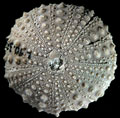The Echinoid Directory
Pseudodiadema Desor, 1855 p. 63
| Diagnostic Features |
|
|---|---|
| Distribution | Upper Jurassic (Oxfordian) to Lower Cretaceous (early Albian) western Europe, Mexico and southern USA. |
| Name gender | neuter |
| Type | Cidarites pseudodiadema Lamarck, 1816, p. 59, by original designation. |
| Species Included |
|
| Classification and/or Status |
|
| Remarks | Distinguished by its small hemicyclic apical disc from all Emiratiidae. Distinguished from Hessotiara by having no sharp decline in the size of ambulacral tubercles on the aboral surface. |




